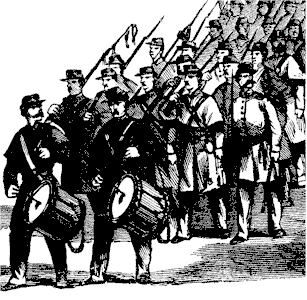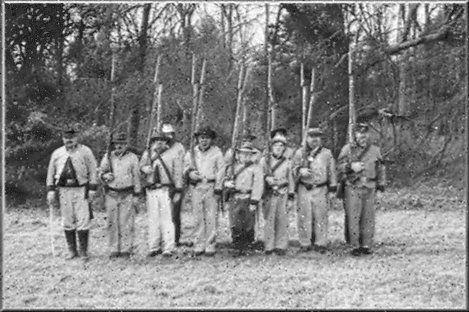











Unit History | Purposes & Objectives| Activities| Activities| To Join| Recruit Guide| Cost| Uniform & Equipment Guide| Enlistment Application
MISSOURIANS!
TO ARMS!

A NEW COMPANY OF
Missouri
Infantry!
IS BEING ACCEPTED
AND WILL BE MUSTERED INTO SERVICE IMMEDIATELY.
Defend your State
from the Northern Invader! Enlist now to re-enact battles, camp, and social
customs of your ancestors.
Join Missouri's premier Civil War reenactment group. The Fifth Missouri Infantry CSA, Inc. portrays confederate troops that began there service as members of the Missouri State Guard, and fought major engagements as Oak Hills (Wilson's Creek), Lexington, Elk Horn Tavern (Pea Ridge), Corinth, The Vicksburg Campaign, The Atlanta Campaign, Franklin Tennessee, and Ft. Blakeley Alabama. Also portrayed are the countless skirmishers and border clashes in Missouri.
The Fifth Missouri Infantry (CSA), Inc. is a non-profit, tax-exempt 501(c)3 organization affiliated with the Missouri Civil War Reenactors Association. The Fifth Missouri is dedicated to the preservation of the memory of the Americans who fought and died for both sides during the War Between the States.
Activities include
frequent reenactments of battles at the local, regional and national levels. In
addition to battles and military drill, reenactors and there families
demonstrate camp life and social customs of the 1860's and give presentations to
schools and civic organizations.

Fifth Missouri Infantry Company A at spring drill 2002
| Unit History | Purposes & Objectives | Activities | To Join |
| Recruit Guide | Cost | Uniform & Equipment Guide | Enlistment Application |
Our primary impression is
that of the Fifth Missouri Infantry, Company A. This unit was formed from
Johnson County recruits and served under General Sterling Price in the Missouri
State Guard, then in General John S. Bowen's division of the Confederate Army of
the West, and eventually under Warrensburg's Brigadier General Francis Marion
Cockrell as part of the Army of Tennessee. While part of the MSG's 8th
Division, the company fought at Carthage, Oak Hills and Lexington Missouri & Elk
Horn Tavern Arkansas. The 5th Missouri Regiment was formed in 1862 in
Mississippi under the command of Col. James P. McCown of Johnson County. Company
A was commanded by Owen A. Waddell of Warrensburg. He was later promoted to
Major and died at Alatoona Pass, Georgia. After Waddell's promotion, Capt. Royal
Stokely commanded the Company until mortally wounded at Port Gibson Mississippi.
Capt. Barnett Atkeson succeeded in command, and died at Franklin Tennessee.
After the fall of Vicksburg, the Regiment was consolidated with the 3rd
Missouri, and served with distinction until eventually surrendering near Mobile
Alabama on April 9, 1865. Some members returned west of the Mississippi River
following Vicksburg and served out the war under General John S. Marmaduke.
Back
to Index
We are a "living
History" organization that tries to depict, with as much historical accuracy as
possible, events and life during the war between the states. We seek to educate
our selves as well as the public about this key era of our nations history. We
do this by participating in camp life and reenactments, as well as by giving
presentation to schools and civic groups. A major facet of reenacting is the
personal enjoyment gained by performing well in front of the public and by
[participation in the camaraderie of the camp. We welcome wives and family
members, & help them find authentic roles to play. Back
to Index
We participate in battle reenactments and skirmishes both large and small;
locally and distant. We average about a dozen events a year. (Attend the ones
you can, Three events will keep your voting status). We also do living history
displays at historic sites and Individual and group presentations to schools,
and civic organizations. We also some times participate as extras in movies and
miniseries (i.e.. "Gettysburg") Back to Index
Expenses of historical reenacting are
moderate, and compare favorably with many other hobbies. After acquiring the
necessary gear, continuing cost are relatively low. If a new reenactor bought
everything at retail, he'd spent about $1,000 to become fully equipped.
Bargains are available and sewing talents cuts the cost considerably. We
normally allow a year or more for a new recruit to acquire all needed gear.
Since we are enjoying federal tax-exempt status as an organization, costs
related to participation are deductible as charitable contributions if you
itemize your returns. Back
to Index
BECOMING A SOLDIER
To be accepted as a
full member of our unit, you must do a number of things. First, you must pay
your dues to the unit and to the Missouri Civil War Reenactors Association.
Second, you must demonstrate a bona fide effort to acquire necessary gear by
making, ordering, or buying a portion of it. Third, you must demonstrate a
desire to learn about reenacting by attending meetings, drills, events and
demonstrations. Finally, you must be recommended by an experienced member of the
unit who has volunteered to be your sponsor. Normally, he will be someone who
lives or works near you, so you can easily contact him to answer your questions.
Your sponsor will also work
with you before your first event so you have some idea of the rudiments of drill
and the manual of arms. When the sponsor feels you have made a sufficient
commitment, and you have fulfilled the requirements set out in the corporate
by-laws, he will recommend to the membership that you be accepted as a Veteran
Soldier. You can participate in the ranks as a recruit before becoming a
Veteran, but only Veterans can vote for field officers or hold rank.
SAFETY
Safety is absolutely
paramount. We can ill afford to injure a spectator or another reenactor, and we
sure don't want to hurt ourselves. However, black power firearms -- like all
guns -- are dangerous if handled carelessly, so we insist that you read and
understand our unit safety guidelines before being allowed to participate in any
field actions.
AUTHENTIC BEHAVIOR
We try to be as
historically accurate as possible, so we do not mislead those watching us. Some
spectators are very knowledgeable about the period we portray, and even minor
errors on our part could discredit our entire impression.
RESEARCH
You'll feel the need
to do some research on your impression, the history of your unit, and history of
the battles you reenact. As you start out, other reenactors are good sources.
Local libraries often have decent civil war collections. When you enlist, we'll
provide you with a suggested reading list along with your guides to drill and
manual of arms.
MILITARY BEARING
We portray military
men, and should remember that discipline was harshly enforced in the 1860's.
While our officers and non-commissioned officers are elected, we should act as
though they had real authority to enforce discipline. We also should understand
that they are not professionals, and don't drill any more often than the
privates, so we need to be understanding of their mistakes and do nothing to
make their job harder. Bitching -- on the other hand -- is authentic and there's
nothing wrong with some good, period complaining if done in the right spirit.
FARBISMS
"Farb" is a term of
unclear origins, which generally means displaying gear or behavior inappropriate
for the time period we portray. For example, modern eyeglasses are "farb."
Synthetic fabrics are "farb." Sleeping bags and ice coolers are "farb", but
acceptable in certain situations if kept concealed from the view of spectators
and other reenactors. Cigarette smoking is "farb", but pipe and cigar smoking
are allowed if appropriate pipes/cigars are used. A good reenactor strives to
eliminate all visible farbisms.
DRINKING
Drunkenness was
frowned upon by the armies of the 1860's and is even more inappropriate today.
Never drink alcoholic beverages when the camps are open to the public. Moderate
consumption after spectator hours will not normally be chastised -- as long as
it does not lead to loud or disruptive behavior and is carried on circumspectly
using your tin cup.
LANGUAGE
Profane language and
racist comments are not to be tolerated. While these were common among the
soldiers of both armies in the 1860's, they are inappropriate in today's
context. Nineteenth Century attitudes can be depicted in an in-offensive manner
with a judicious selection of terms. Twentieth Century language and terms can be
used when explaining things to visitors around camp, but discussion of
20th-Century subjects should be avoided until after visitors have departed.
Back
to Index
| Uniform & Equipment Guide |
MINIMUM REQUIREMENTS
To meet the
Veteran Voting Status.
FOOTWEAR: M1855 Jefferson
Brogan with heal plates.
TROUSERS: Military Jean Wool
gray.
PERIOD HAT: Military Kepi
Jean Wool gray or Civilian.
MUSKET: Three-band .577 cal.
P1853 Enfield Preferred. (Armi-sport suggested)
Acceptable
weapons 1842 or 1861 Springfield Three-band .577 cal
LEATHER ACCOUTERMENTS:
Cartridge box with sling, cap box, Waist belt.
REQUIRED WITH IN 12 MONTHS
To meet standards.
SHELL JACKET: Columbus Depot
Style Type I or II (Western Theater), Jean Wool gray with French Blue
Collar and cuffs.
FEDERAL SACK COAT: Federal 4
button.
FEDERAL TROUSERS: Military
Federal Sky blue kersey.
FEDERAL HAT: Military Kepi
dark blue or Black Civilian.
SOCKS: Wool.
CANTEEN: Any period type.
HAVERSACK: Federal Issue
("Tarred" or White), or Home made.
BAYONET WITH SCABBARD:
Appropriate to weapon.
OTHER ESSENTIAL ITEMS
PERIOD EYE GLASSES: Contacts
acceptable
SUSPENDERS: Linen, Canvas,
Leather, or Ticking (NO Elastic)
MESS KIT: Tin cup, Tin
plate, period type Fork & Spoon
WOOL BLANKET(S): Or period
type Quilt.
SHELTER: M1862 Shelter
Halves, Rubber gum blanket or poncho. A-tent acceptable.
OPTIONAL EQUIPMENT
Extra Shirts
Additional Trousers
Federal Double Knapsack
Period Underwear
Period Personal Items
Civilian Clothing (Frock or
Sack Coat) Vest
Overcoat (Federal)
Revolvers
Percussion Shotgun
Alternative hat (Civilian if
your primary hat is Military)
KEEP YOUR RECEIPTS! Since the Fifth Missouri Infantry CSA Inc. is is a non-profit, tax-exempt 501(c)3 organization, your dues and all legitimate expenses with reenacting are tax-deductible.
Back to
Index
Here are some links to Sutlers that have
been used by members of the Fifth Missouri.
|
|||
|
|||
|
|||
|
|||
|
| To Join |
Follow the link to the
Enlistment Application. Print the form on your
computer and fill it out and mail back to the address listed with your dues.
You may also bring the completed form to our next event. We'll tell you more
about what we do and let you decide for yourself before you make any financial
commitment. Membership dues entitle you yo voting rights for corporate
officers, and a monthly news letter dealing with our activities. in order to
become a member of the fifth Missouri Infantry, membership in the regional MCWRA
is also required.
Back to Index
![]()
The Fifth Missouri Infantry C.S.A. Inc. is not affiliated with any religious, political, or any connection with hate organizations.
Contact Site Administrator at coa5thmo@mchsi.com